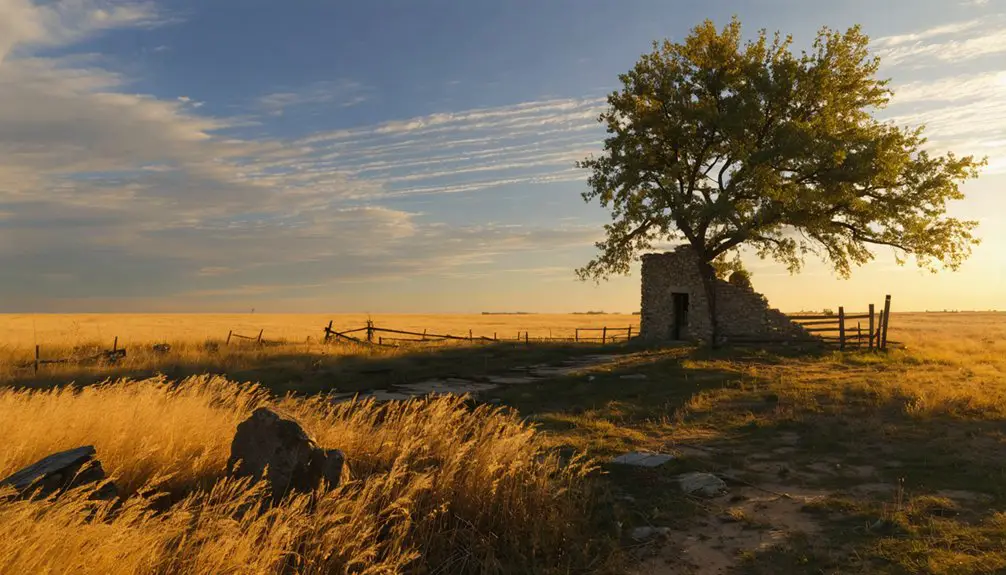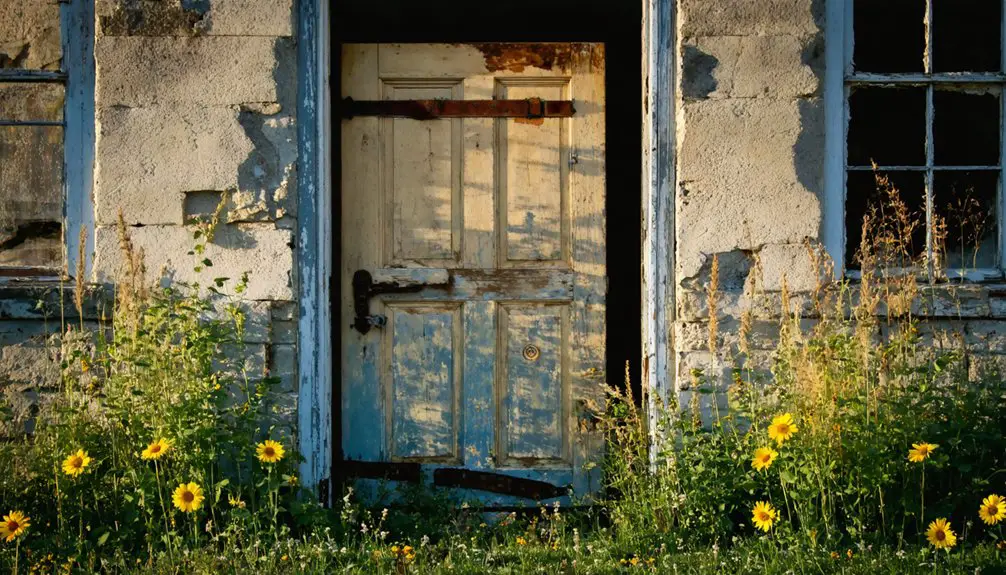You’ll find Fostoria, Kansas along the former Leavenworth, Kansas and Western Railway line, where it emerged as a bustling railroad town in 1884. At its peak in 1910, this prairie settlement boasted 125 residents, Times Square’s twenty businesses, and essential services like a bank, telegraph office, and the Cottage Hotel. Today, weathered historic buildings and an old Baptist church stand as silent sentinels, each brick and timber holding stories of Kansas’s railroad glory days.
Key Takeaways
- Fostoria emerged as a Kansas railroad town in 1884, reaching a peak population of 125 residents by 1910.
- The town’s decline began with the destruction of its mill by fire in 1931 and changes in railroad routes.
- Times Square once featured 20 businesses, including a bank, telegraph office, and the distinctive triangular Roscoe Carle newspaper building.
- Original structures still standing include business buildings and an old Baptist Church, though many are now in decay.
- The post office, established in 1884, served as the town’s communication hub for nearly 90 years before closure.
From Railroad Station to Ghost Town: The Birth of Fostoria
Three key developments marked Fostoria’s birth as a railroad town in Pottawatomie County, Kansas.
First, the Leavenworth, Kansas and Western Railway established a station there as part of the post-Civil War railroad expansion, creating a crucial transportation link for the region. The intense period of railroad building boom that swept across the United States from 1868 to 1873 contributed to Fostoria’s establishment.
The railway’s arrival marked a turning point, as the new station connected Fostoria to the region’s expanding post-Civil War railroad network.
Second, the federal government’s land grants positioned Fostoria strategically along the rail line, about eight miles northwest of Westmoreland and six miles east of Olsburg.
Third, the establishment of a post office in 1884 provided official recognition and essential communication services to the fledgling community.
Despite these promising beginnings, you’ll find that community growth remained modest. By 1910, the population reached 125 residents with several businesses operating in the town.
Life in Early Fostoria: Business and Community
A vibrant commercial district known as Times Square formed the heart of early Fostoria, where you’d find roughly 20 businesses clustered around the central intersection. The Roscoe Carle newspaper occupied the distinctive triangular building at the center. You could handle your banking, send telegrams, mail packages, or stock up at the general store. The Cottage Hotel welcomed travelers passing through town.
The community infrastructure reflected a town built for permanence. You’d walk on dirt streets later upgraded to brick by local craftsmen. Your children would attend the local school, while Sunday mornings might find you at the Baptist church. Much like the homesteaders of Amy who waited until 1905 for an elevator, Fostoria’s residents gradually built up their town’s amenities.
The Rise and Fall of a Kansas Railroad Town
When the Leavenworth, Kansas, and Western Railway established a station in Shannon Township during the 1880s, Fostoria emerged as a promising railroad hub in Pottawatomie County.
Like the thriving Modoc stockyards, the town developed significant railway infrastructure to support transportation needs.
As railroad expansion brought new opportunities, you’d have found a bustling community taking shape along Sandusky Street, where dual railroad tracks served both freight and passenger needs.
The town’s growth followed this pattern:
- A post office opened in 1884, marking Fostoria’s official establishment
- By 1910, the population reached 125 residents
- The community thrived with a bank, telegraph office, and mill
- Electric interurban service connected residents to Fremont and Cleveland
Yet despite early promise, economic decline set in.
The mill’s destruction by fire in 1931 signaled changing times, and by the 1970s, the post office closed, marking the end of Fostoria’s railroad era.
Standing Still: Present-Day Fostoria’s Historic Buildings
Today, scattered remnants of Fostoria’s prosperous past stand silently along its historic streets, with several original business buildings, an old Baptist Church, and a handful of preserved homes marking what was once a thriving railroad community.
Similar to German architecture in Kolmanskop, Fostoria’s historical buildings showcase unique design elements from its early settlement period.
While architectural preservation efforts remain informal, you’ll find practical features throughout these weathered structures, including built-in bookcases, fireplaces, and remnants of second-story staircases.
Like many Kansas settlements that became ghost towns, Fostoria’s decline was linked to shifting railroad routes and economic changes.
Time and nature have taken their toll, evident in cracking paint, fading wallpaper, and partially collapsed roofs. Despite its ghost town status, Fostoria maintains its historical significance as a small community, though it’s lost key infrastructure like its post office, which closed in the 1970s.
Like many forgotten towns, Fostoria’s decaying buildings tell stories of a vibrant past, now fading with each passing season.
The surrounding rural landscape enhances the quiet atmosphere, offering glimpses into late 19th-century Kansas railway town life.
Legacy of a Lost Prairie Settlement

Though Fostoria’s origins trace back to the Leavenworth, Kansas, and Western Railway’s expansion in 1884, its legacy extends beyond mere railroad history.
Today, you’ll find a representation of prairie evolution, where community nostalgia lingers in the remnants of what was once a bustling railway stop.
As you explore Fostoria’s story, you’ll discover four key elements that shaped its journey:
- A vibrant post office that served as the town’s lifeline for nearly 90 years
- A resilient local economy that supported a bank, telegraph, and express offices
- An agricultural transformation that reflected Kansas’s shifting economic landscape
- A lasting imprint on regional transportation networks
Like many Kansas settlements, bad weather and severe economic downturns contributed significantly to the town’s eventual decline.
Similar to nearby towns like Irving, severe grasshopper invasions devastated local crops and vegetation, challenging the community’s agricultural foundation.
While the physical town has faded, Fostoria’s tale embodies the spirit of small-town Kansas and its adaptability to change.
Frequently Asked Questions
What Native American Tribes Originally Inhabited the Fostoria Area?
You’ll find the Kanza (Kaw) tribe primarily inhabited this area, with significant tribal history near Mission Creek, while Osage, Pawnee, and Comanche peoples maintained cultural significance through hunting and seasonal presence.
Did Any Notable Historical Figures Ever Visit or Live in Fostoria?
Like a blank page in history’s book, you won’t find any notable figures in Fostoria’s visitors log. Historical records don’t show any famous residents or significant personalities throughout Fostoria history.
What Was the Average Land Price in Fostoria During Its Peak?
You’d likely have found land valuation in the range of $10-50 per acre during peak years, influenced by economic factors like railway access, though exact records aren’t available for Fostoria’s prices.
Were There Any Significant Natural Disasters That Affected Fostoria’s Development?
You won’t find any recorded significant natural disasters shaping Fostoria’s story. Unlike other Kansas ghost towns struck by nature’s fury, economic impacts and railway-related factors drove this town’s gradual decline.
What Happened to the Families Who Left Fostoria During Its Decline?
You’ll find these families relocated due to economic impact, moving to nearby towns like Westmoreland and Olsburg for better opportunities. Their family migration followed regional trends toward urban centers and larger farming communities.
References
- https://legendsofkansas.com/fostoria-kansas/
- https://www.youtube.com/watch?v=iB5rHT14eVI
- https://www.hhhistory.com/2019/05/ghost-towns-of-kansas.html
- https://www.youtube.com/watch?v=ie3zwwHm2Jg
- https://www.youtube.com/watch?v=alC1wDdSVvg
- http://kansasheritage.org/research/rr/rrhistory.html
- https://en.wikipedia.org/wiki/Kansas_Pacific_Railway
- https://tscpl.org/articles/local-history-choose-your-depot
- https://legendsofkansas.com/pottawatomie-county-extinct-towns/
- https://fhsuguides.fhsu.edu/kansasheritage/lanecounty



